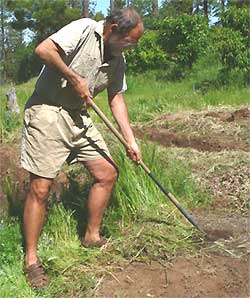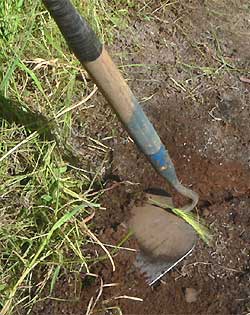 Broccoli plants mulched with scalped lawngrass, replacing the previous lawn
Broccoli plants mulched with scalped lawngrass, replacing the previous lawnSTEP 1: THINKING ABOUT THE PROJECT
Is the soil beneath your lawn acceptable for growing vegetables? Unless it's been thoroughly poisoned with industrial waste or some other long-lived contaminant, surely it is. Usually the contaminants of most concern are lead, arsenic and asbestos.
Most lawn pesticides are designed to break down fairly quickly. The US Enironmental Protection Agency provides a freely available online document entitled Growing Gardens in Urban Soils If your soil is too polluted, consider using a "raised bed system," bringing in your soil or other growing medium from elsewhere. Mother Earth News provides lots of information about chemical-free gardening.
Remember that one form of gardening, hydroponics, doesn't even use soil. Hydroponics proves that there's nothing magical about soil. Greentrees Hydroponics offers a good introduction to the topic on its Hydroponic Gardening For Beginners page. Even if the soil is rocky, so hard that it's brittle, or full of trash, you can grow things in it. However, if it contains broken glass or other sharp items, it would be unwise to work the soil with one's hands.
If your soil is poor, it can be improved in a number of ways, though it may take several years to do so. Still, even poor soil, when properly managed, can grow things.
Therefore, unless your lawn soil is full of dangerous contaminants or objects that can cut you, there's no reason for you not to convert your lawn to garden, but many reasons for you to do so.
STEP 2: SCALP THE SOD AWAY

Use a hoe as shown at the right, working backwards, scalping where you've just been. As you move across an area, the sod balls up between you and the hoe, so periodically pick up the loose material and carry it away. Unless it's full of weed seeds, rhizomes or stolen from which new weeds might arise, use it as mulch or compost it.

At the left, notice how one corner of the hoe's blade is brought toward you, not the blade's flat bottom. Somehow this helps the blade cut grass roots and move through the soil. Here's an important suggestion for scalping sod with a hoe: Keep your hoe's blade sharp! After every half hour or so you should file your blade's head to a fine sharpness. Cut deeply enough to remove sprout-forming rhizomes of such things as crabgrass, but don't remove too much dirt.
STEP 3: LOOSEN THE SOIL

Once the plot is grassless, probably you'll be confronted with a plot of hard-packed dirt -- as opposed to hard-packed soil, which is an evolving ecosystem of interconnected living and non-living components. Now the job is to loosen the soil.
On TV sometimes garden tillers are shown churning up good-looking soil with hardly any effort at all. Maybe something like that is possible, but this gardener's experience is that easy tilling is done only where the soil already is fairly loose. Starting with hard-compacted soil, the best way to do it is with a shovel, one shovelful at a time, which is being done at the right.
All that chopping and shoveling may seem like an awful lot of work, and it is. However, if you do just a few minutes each day, day after day, you'll be surprised how large a garden spot you have after a week of work. Doing it makes a good meditation.
STEP 4: ADD ORGANIC MATTER

In the garden, nearly all problems are diminished by adding organic matter. The University of Minnesota Extension web page entitled Compost and soil organic matter: The more, the merrier? considers soil organic matter "The 'first National Bank' of soil"; "Deposit" organic matter, and "withdraw" more benefit than was deposited.
Above, that's the kind of soil you're shooting for. It's dark, crumbly, stays moist a long time, smells "earthy" and fungusy, and earthworms thrive in it. That's the goal. Once you have a backyard plot of it, then start gardening.